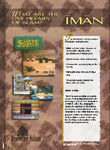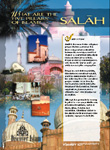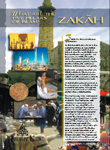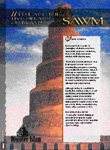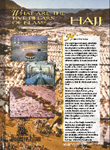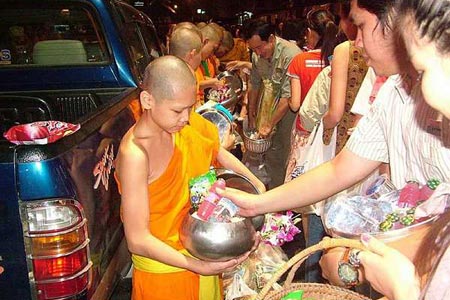


REPRESENTATIVE of the attitude of Christendom toward Islam, till recent years at least, is Alexander Ross's postscript to the Anglicized version, published in 1649, of Sieur Du Ryer's French translation of the Koran. The author of the postscript directs the following invective against Mohammed and the Koran:
"Good Reader, the great Arabian Impostor now at last after a thousand years, is by the way of France arrived in England, and his Alcoran, or gallimaufry of errors, (a brat as deformed as the parent, and as full of heresies as his scald head was of scurvy) hath learned to speak English. * * * If you will take a brief view of the Alcoran, you shall find it a hodgepodge made up of these four ingredients: 1. Of Contradictions. 2. Of Blasphemy. 3. Of ridiculous Fables. 4. Of Lies."
The accusation of blasphemy is emphasized against Mohammed because he affirmed that God, being unmarried, was incapable of having a Son! The fallacious argument, however, is apparent from the Prophet's own views of the nature of God as contained in the second sura of the Koran:
"To Allah [God] belongeth the east and the west; therefore, whithersoever ye turn yourselves to pray, there is the face of Allah; for Allah is omnipresent and omniscient. They say, Allah hath begotten children: Allah forbid! To him belongeth whatever is in heaven, and on earth; all is possessed by him, the Creator of heaven and earth; and when he decreeth a thing, he only saith unto it, Be, and it is." In other words, the God of Islam has but to desire and the object of that desire at once comes into being, whereas the God of Alexander Ross must proceed in accord with the laws of human generation!
Mohammed, Prophet of Islam, "the desired of all nations," was born in Mecca, A.D. 570 (?) and died in Medina, A.D. 632, or in the eleventh ),ear after the Hegira. Washington Irving thus describes the signs and wonders accompanying the birth of the Prophet:
"His mother suffered none of the pangs of travail. At the moment of his coming into the world a celestial light illumined the surrounding country, and the new born child, raising his eyes to heaven, exclaimed: 'God is great! There is no God bur God, and I am his prophet!' Heaven and earth, we are assured, were agitated at his advent. The Lake Sawa shrank back to its secret springs, leaving its borders dry; while the Tigris, bursting its bounds, overflowed the neighboring lands. The palace of Khosru the king of Persia shook t on its foundations, and several of its towers were toppled to the earth. * * * In the same eventful night the sacred fire of Zoroaster, which, guarded by the Magi, had burned without interruption for upward of a thousand years, was suddenly extinguished, and all the idols in the world fell down." (See Mahomet and His Successors.)
While the Prophet was still but a toddling babe, the Angel Gabriel with seventy wings came to him, and cutting open the child, withdrew the heart. This Gabriel cleansed of the black drop of original sin which is in every human heart because of the perfidy of Adam and then returned the organ to its proper place in the Prophet's body. (See footnote in E. H. Palmer's translation of the Qur'an.)
In his youth Mohammed traveled with the Meccan caravans, on one occasion acted as armor-bearer for his uncle, and spent a considerable time among the Bedouins, from whom he learned many of the religious and philosophic traditions of ancient Arabia. While traveling with his uncle, Abu Taleb, Mohammed contacted the Nestorian Christians, having encamped on a certain night near one of their monasteries. Here the young Prophet-to-be secured much of his information concerning the origin and doctrines of the Christian faith.
With the passing years Mohammed attained marked success in business and when about twenty-six years old married one of his employers, a wealthy widow nearly fifteen years his senior. The widow, Khadijah by name, was apparently somewhat mercenary, for, finding her young business manager most efficient, she resolved to retain him in that capacity for life! Khadijah was a woman of exceptional mentality and to her integrity and devotion must be ascribed the early success of the Islamic cause. By his marriage Mohammed was elevated from a position of comparative poverty to one of great wealth and power, and so exemplary was his conduct that he became known throughout Mecca as "the faithful and true."
Mohammed would have lived and died an honored and respected Meccan had he not unhesitatingly sacrificed both his wealth and social position in the service of the God whose voice he heard while meditating in the cavern on Mount Hira in the month of Ramadan. Year after year Mohammed climbed the rocky and desolate slopes of Mount Hira (since called Jebel Nur, "the Mountain of light") and here in his loneliness cried out to God to reveal anew the pure religion of Adam, that spiritual doctrine lost to mankind through the dissensions of religious factions. Khadijah, solicitous over her husband's ascetic practices which were impairing his physical health, sometimes accompanied him in his weary vigil, and with womanly intuition sensed the travail of his soul. At last one night in his fortieth year as he lay upon the floor of the cavern, enveloped in his cloak, a great light burst upon him. Overcome with a sense of perfect peace and understanding in the blessedness of the celestial presence, he lost consciousness. When he came to himself again the Angel Gabriel stood before him, exhibiting a silken shawl with mysterious characters traced upon it. From these characters Mohammed gained the basic doctrines later embodied in the Koran. Then Gabriel spoke in a clear and wonderful voice, declaring Mohammed to be the Prophet of the living God.
In awe and trembling, Mohammed hastened to Khadijah, fearing the vision to have been inspired by the same evil spirits who served the pagan magicians so greatly despised by him, Khadijah
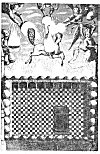
Click to enlarge
MOHAMMED'S NIGHT JOURNEY TO HEAVEN.
From D'Ohsson's Tableau Général de l'Empire Othoman.
In the seventeenth sura of the Koran it is written that upon a certain night Mohammed was transported from the temple at Mecca to that of Jerusalem, but no details are given of the strange journey. In the Mishkāteu ’l-Masabih, Mohammed is made to describe his ascent through the seven heavens into the icy presence of the may-veiled God and his subsequent return to his own bed, all in a single night. Mohammed was awakened in the night by the Angel Gabriel, who, after removing the Prophet's heart, washed the cavity with Zamzam water, and filled the heart itself with faith and science. A strange creature, called Alborak, or the lightning bolt, was brought for the conveyance of the Prophet. Alborak is described as white animal of the shape and size of a mule, with the head of a woman and the tail of a peacock. According to some versions, Mohammed merely rode Alborak to Jerusalem, where, dismounting upon Mount Moriah, he caught hold of the lower rung of a golden ladder lowered from heaven and, accompanied by Gabriel, ascended through the seven spheres separating he earth from the inner surface of the empyrean. At the gate of each sphere stood me of the Patriarchs, whom Mohammed saluted as he entered the various planes. At the gate of the first heaven stood Adam; at the gate of the second, John and Jesus (sisters' sons); at the third, Joseph; at the fourth, Enoch; at the fifth, Aaron; at the sixth, Moses; and at the seventh, Abraham. Another order of the Patriarchs and prophets is given which places Jesus at the gate of the seventh heaven, and upon reaching this Point Mohammed is said to have requested Jesus to intercede for him before the throne of God.
p. 190
assured him that his own virtuous life would be his protection and that he need fear no evil. Thus reassured, the Prophet awaited further visitations from Gabriel. When these did not come, however, such a despair filled his soul that he attempted self-destruction, only to be stopped in the very act of casting himself over a cliff by the sudden reappearance of Gabriel, who again assured the Prophet that the revelations needed by his people would be given to him as necessity arose.
Possibly as a result of his lonely periods of meditation, Mohammed seemingly was subject to ecstatic swoons. On the occasions when the various suras of the Koran were dictated he is said to have fallen unconscious, and, regardless of the chill of the surrounding air, to have been covered with beads of perspiration. Often these attacks came without warning; at other times he would sit wrapped in a blanket to prevent a chill from the copious perspiration, and while apparently unconscious would dictate the various passages which a small circle of trusted friends would either commit to memory or reduce to writing. On one occasion in later life when Abu Bekr referred to the gray hairs in his beard, Mohammed, lifting the end of his beard and looking at it, declared its whiteness to be due to the physical agony attendant upon his periods of inspiration.
If the writings attributed to Mohammed be considered as merely the hallucinations of an epileptic--and for that reason discounted--his Christian detractors should beware lest with the doctrines of the Prophet they also undermine the very teachings which they themselves affirm, for many of the disciples, apostles, and saints of the early church are known to have been subject to nervous disorders. Mohammed's first convert was his own wife, Khadijah, who was followed by other members of his immediate family, a circumstance which moved Sir William Muir to note:
"It is strongly corroborative of Mohammed's sincerity that the earliest converts to Islam were not only of upright character, but his own bosom friends and people of his household; who, intimately acquainted with his private life, could not fail otherwise to have detected those discrepancies which ever more or less exist between the professions of the hypocritical deceiver abroad and his actions at: home." (See The Life of Mohammad.)
Among the first to accept the faith of Islam was Abu Bekr, who became Mohammed's closest and most faithful friend, in fact his alter ego. Abu Bekr, a man of brilliant attainments, contributed materially to the success of the Prophet's enterprise, and in accord with the express wish of the Prophet became the leader of the faithful after Mohammed's death. A’isha, the daughter of Abu Bekr, later became the wife of Mohammed, thus still further cementing the bond of fraternity between the two men. Quietly, but industriously, Mohammed promulgated his doctrines among a small circle of powerful friends. When the enthusiasm of his followers finally forced his hand and he publicly announced his mission, he was already the leader of a strong and well-organized faction. Fearing Mohammed's growing prestige, the people of Mecca, waiving the time-honored tradition that blood could not be spilt within the holy city, decided to exterminate Islam by assassinating the Prophet. All the different groups combined in this undertaking so that the guilt for the crime might thereby be more evenly distributed. Discovering the danger in time, Mohammed left his friend Ali in his bed and fled with Abu Bekr from the city, and after adroitly eluding the Meccans, joined the main body of his followers that had preceded him to Yathrib (afterwards called Medina). Upon this incident-called the Hegira or "flight"--is based the Islamic chronological system.
Dating from the Hegira the power of the Prophet steadily grew until in the eighth year Mohammed entered Mecca after practically a bloodless victory and established it as the spiritual center of his faith. Planting his standard to the north of Mecca, he rode into the city, and after circling seven times the sacred Caaba, ordered the 360 images within its precincts to be hewn down. He then entered the Caaba itself, cleansed it of its idolatrous associations, and rededicated the structure to Allah, the monotheistic God of Islam. Mohammed next granted amnesty to all his enemies for their attempts to destroy him. Under his protection Mecca increased in power and glory, becoming the focal point of a great annual pilgrimage, which even to this day winds across the desert in the months of pilgrimage and numbers over threescore thousand in its train.
In the tenth year after the Hegira, Mohammed led the valedictory pilgrimage and for the last time rode at the head of the faithful along the sacred way leading to Mecca and the Black Stone. As the premonition of death was strong upon him, he desired this pilgrimage to be the perfect model for all the thousands that would follow.
"Conscious that life was waning away within him," writes Washington Irving, "Mahomet, during this last sojourn in the sacred city of his faith, sought to engrave his doctrines deeply in the minds and hearts of his followers. For this purpose he preached frequently in the Caaba from the pulpit, or in the open air from the back of his camel. 'Listen to my words,' would he say, 'for I know not whether, after this year, we shall ever meet here again. Oh, my hearers, I am but a man like yourselves; the angel of death may at any time appear, and I must obey his summons."' While thus preaching, the very heavens are said to have opened and the voice of God spoke, saying: "This day I have perfected your religion, and accomplished in you my grace." When these words were uttered the multitude fell down in adoration and even Mohammed's camel knelt. (See Mahomet and His Successors.) Having completed the valedictory pilgrimage, Mohammed returned to Medina.
In the seventh year after the Hegira (A.H. 7) an attempt was made at Kheibar to poison the Prophet. As Mohammed took the first mouthful of the poisoned food, the evil design was revealed to him either by the taste of the meat or, as the faithful believe, by divine intercession. He had already swallowed a small portion of the food, however, and for the remainder of his life he suffered almost constantly from the effects of the poison. In A.H. 11, when his final illness came upon him, Mohammed insisted that the subtle effects of the poison were the indirect cause of his approaching end. It is related that during his last sickness he rose one night and visited a burial ground on the outskirts of Medina, evidently believing that he, too, would soon be numbered with the dead. At this time he told an attendant that the choice had been offered him of continuing his physical life or going to his Lord, and that he had chosen to meet his Maker.
Mohammed suffered greatly with his head and side and also from fever, but on June 8th seemed convalescent. He joined his followers in prayer and, seating himself in the courtyard, delivered a lecture to the faithful in a clear and powerful voice. Apparently he overtaxed his strength, for it was necessary to assist him into the house of A’isha, which opened into the court of the mosque. Here upon a tough pallet laid on the bare floor the prophet of Islam spent his last two hours on earth. When she saw that her aged husband was suffering intense pain, A’isha--then but a girl of twenty--lifting the gray head of the man she had known from infancy and who must have seemed more like a father than a husband, supported him in her arms until the end. Feeling that death was upon him, Mohammed prayed: "O Lord, I beseech Thee, assist me in the agonies of death." Then almost in a whisper he repeated three times: "Gabriel, come close unto me." (For details consult The Life of Mohammad by Sir William Muir.) In The Hero as Prophet, Thomas Carlyle writes thus of the death of Mohammed: "His last words were a prayer, broken ejaculations of a heart struggling-up in trembling hope towards its Maker."
Mohammed was buried under the floor of the apartment in which he died. The present condition of the grave is thus described:
"Above the Hujrah is a green dome, surmounted by a large gilt crescent, springing from a series of globes. Within the building are the tombs of Muhammad, Abū Bakr, and ’Umar, with a space reserved for the grave of our Lord Jesus Christ, who Muslims say will again visit the earth, and die and be buried at al-Madīnah. The grave of Fātimah, the Prophet's daughter, is supposed to be in a separate part of the building, although some say she was buried in Baqī’. The Prophet's body is said to be stretched full length on the right side, with the right palm supporting the right check, the face fronting Makkah. Close behind him is placed Abū Bakr, whose face fronts Muhammad's shoulder, and then ’Umar, who occupies the same position with respect to his predecessor. Amongst Christian historians there is a popular story to the effect that Muhammadans believed the coffin of their Prophet to be suspended in the air, which has no foundation whatever in Muslim literature, and Niebuhr thinks the story must have arisen from the rude pictures sold to strangers. (See A Dictionary of Islam.)
Concerning the character of Mohammed there have been the grossest misconceptions. No evidence exists to support the charges of extreme cruelty and licentiousness laid at his door. On the other hand, the more closely the life of Mohammed is scrutinized by dispassionate investigators, the more apparent become the finer qualities of his nature. In the words of Carlyle:
"Mahomet himself, after all that can be said about him, was nor, a sensual man. We so err widely if we consider this man as a common voluptuary, intent mainly on base enjoyments--nay, on enjoyments of any kind. His household was of the frugalest, his common diet barley bread and water. Sometimes for months there was not a fire once lighted on his hearth. * * * A poor, hard-working, ill-provided man; careless of what vulgar man toiled for. * * * They called him a Prophet, you say? Why, he stood there face to face with them; there, not enshrined in any mystery, visibly clouting his own cloak, cobbling his own shoes, fighting, counselling, ordering in the midst of them, they must have seen what kind of a man he was, let him be called what you like! No emperor with his tiaras was obeyed as this man in a cloak of his own clouting."
Confused by the apparently hopeless task of reconciling the life of the Prophet with the absurd statements long accepted as authentic, Washington Irving weighs him in the scales of fairness.
p. 191
"His military triumphs awakened no pride nor vainglory, as they would have done had they been effected for selfish purposes. In the time of his greatest power, he maintained the same simplicity of manners and appearances as in the days of his adversity. * * * It is this perfect abnegation of self, connected with this apparent heartfelt piety, running throughout the various phases of his fortune, which perplex one in forming a just estimate of Mahomet's character. * * * When he hung over the death-bed of his infant son Ibrahim, resignation to the will of God was exhibited in his conduct under this keenest of afflictions; and the hope of soon rejoining his child in Paradise was his consolation." (See Mahomet and His Successors.)
A'isha, questioned after the death of the Prophet concerning his habits, replied that he mended his own clothes, cobbled his own shoes, and helped her in the household duties. How far removed from Western concepts of Mohammed's sanguinary character is A’isha's simple admission that he loved most of all to sew! He also accepted the invitations of slaves and sat at meals with servants, declaring himself to be a servant. Of all vices he hated lying the most. Before his death he freed all his slaves. He never permitted his family to use for personal ends any of the alms or tithe money given by his people. He was fond of sweetmeats and used rain water for drinking purposes. His time he divided into three parts, namely: the first he gave to God, the second to his family, and the third to himself. The latter portion, however, he later sacrificed to the service of his people. He dressed chiefly in white but also wore red, yellow, and green. Mohammed entered Mecca wearing a black turban and
bearing a black standard. He wore only the plainest of garments, declaring that rich and conspicuous raiment did not become the pious, and did not remove his shoes at prayer. He was particularly concerned with the cleanliness of his teeth and at the time of his death, when too weak to speak, indicated his desire for a toothpick. When fearful of forgetting something, the Prophet tied a thread to his ring. He once had a very fine gold ring but, noting that his followers had taken to wearing similar rings in emulation of him, he removed his own and threw it away lest his followers form an evil habit. (See The Life of Mohammad.)
The most frequent, and apparently the most damaging, accusation brought against Mohammed is that of polygamy. Those who sincerely believe the harem to be irreconcilable with spirituality should with consistency move for the expurgation of the Psalms of David and the Proverbs of Solomon from the list of inspired writings, for the harem of Islam's Prophet was insignificant compared with that maintained by Israel's wisest king and the reputed favorite of the Most High! The popular conception that Mohammed taught that woman had no soul and could attain heaven only through marriage is not substantiated by the words and attitude of the Prophet during his lifetime. In a paper entitled The Influence of Islam on Social Conditions, read at the World's Parliament of Religions held in Chicago, in 1893, Mohammed Webb states the charge and answers it thus:
"it has been said that Mohammed and the Koran denied a soul to woman and ranked her with the animals. The Koran places her
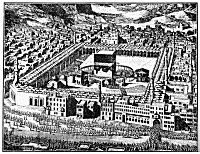
Click to enlarge
THE CAABA, THE HOLY PLACE OF ISLAM.
Section from panorama of Mecca in D'Ohsson's Tableau Général de l'Empire Othman.
The Caaba, or cube-shaped building in the midst of the great court of the mosque at Mecca, is the most holy spot in the Islamic world. Toward it the followers of the Prophet must face five times a day at the appointed hours of prayer. Like the devotees of nearly all other faiths, the Mussulman originally faced the East while in prayer, but by a later decree he was ordered to turn his face toward Mecca.
Little is known of the history of the Caaba prior to its rededication as a Mohammedan mosque, other than that the building was a pagan temple. At the time the Prophet captured Mecca, the Caaba and surrounding court contained 360 idols, which were destroyed by Mohammed before he actually gained access to the shrine itself. The "Ancient House," as the Caaba is called, is an irregular cube measuring about 38 feet in length, 35 feet in height, and 30 feet in width. The length of each side wall varies slightly and that of the end walls over a foot. In the southeast corner of the wall at a convenient distance above the ground (about five feet) is embedded the sacred and mysterious black stone or aerolite of Abraham. When first given to that patriarch by the Angel Gabriel this stone was of such strong whiteness as to be visible from every part of the earth, but late, it became black because of the sins of man. This black stone, oval in shape and about seven inches in diameter, was broken in the seventh century and is now held together by a silver mounting.
According to tradition, 2,000 years before the creation of the world the Caaba was first constructed in heaven, where a model of it still remains. Adam erected the Caaba on earth exactly below the spot in heaven occupied by the original, and selected the stones from the five sacred mountains Sinai, al-Judī, Hirā, Olivet, and Lebanon. Ten thousand angels were appointed to guard the structure. At the time of the Deluge the sacred house was destroyed, but afterward was rebuilt by Abraham and his son Ishmael. (For details see A Dictionary of Islam). It is probable that the site of the Caaba was originally occupied by a prehistoric stone altar or ring of uncut monoliths similar to those of Stonehenge. Like the temple at Jerusalem, the Caaba has undergone many vicissitudes, and the present structure does not antedate the seventeenth century of the Christian Era. When Mecca was sacked in A.D. 930, the famous black stone was captured by the Carmathians, in whose possession it remained over twenty years and it is a moot question whether the stone finally returned by them in exchange far a princely ransom was actually the original block or a substitute.
The side of the Caaba are the supposed graves of Hagar and Ishmael, and near the door (which is about seven feet above the ground) is the stone upon which Abraham stood while rebuilding the Caaba. Various coverings have always been thrown over the cube-shaped structure; the present drape, which is replaced annually, is a black brocade embroidered in a gold. Small pieces a the old drape are cherished by pilgrims as holy relics.
Entrance to the Caaba is effected by a movable flight of steps. The interior is lined with varicolored marble, silver, and gilt. Although the building is generally conceived to be windowless, this point is disputed. Access to the roof is had through a silver-plated door. In addition to the sacred books the Caaba contains thirteen lamps. The great courtyard around the building contains a number of holy objects, and is bounded by a colonnade which originally consisted of 360 pillars. Opening into the courtyard are nineteen gates, the sacred and significant number of the Metonic Cycle and also the number of stones in the inner ring of Stonehenge. Seven great minarets tower above the Caaba, and one of the sacred ceremonials in connection with the building includes seven circumambulations about the central Caaba in an apparent effort to portray the motion of the celestial bodies.
p. 192
on a perfect and complete equality with man, and the Prophet's teachings often place her in a position superior to the male in some respects." Mr. Webb justifies his stand by quoting from the thirty-fifth verse of the thirty-third sura of the Koran:
"Verily the Moslems of either sex, and the true believers of either sex, and the devout men, and the devout women, and the men of veracity, and the women of veracity, and the patient men, and the patient women, and the humble men, and the humble women, and the alms-givers of either sex, and the men who fast, and the women who fast, and the chaste men, and the chaste women, and those of either sex who remember Allah frequently: for them hath Allah prepared forgiveness and a great reward." Here the attainment of heaven is clearly set forth as a problem whose only solution is that of individual merit.
On the day of his death Mohammed told Fatima, his beloved daughter, and Safiya, his aunt: "Work ye out that which shall gain acceptance for you with the Lord: for I verily have no power with Him to save you in any wise." The Prophet did not advise either woman to rely upon the virtues of her husband nor in any manner did he indicate woman's salvation to be dependent upon the human frailty of her spouse.
Everything to the contrary notwithstanding, Mohammed is not responsible for the contradictions and inconsistencies in the Koran, for the volume was not compiled and did not assume its present form until over twenty years after his death. In its present state the Koran is, for the major part, a jumble of hearsay through which occasionally shines forth an example of true inspiration. From what is known of the man Mohammed, it is reasonable to suppose that these nobler and finer portions represent the actual doctrines of the Prophet; the remainder are obvious interpolations, some arising from misunderstanding and others direct forgeries calculated to satisfy the temporal ambitions of conquering Islam. On this subject, Godfrey Higgins speaks with his usual perspicacity:
"Here we have the Koran of Mohammed and the first four sincere and zealous patriarchs, and the Koran of the conquering and magnificent Saracens--puffed up with pride and vanity. The Koran of the eclectic philosopher was not likely to suit the conquerors of Asia. A new one must be grafted on the old, to find a justification for their enormities." (See Anacalypsis.)
To the discerning few it is evident that Mohammed had a knowledge of that secret doctrine which must needs constitute the core of every great philosophical, religious, or ethical institution. Through one of four possible avenues Mohammed may have contacted the ancient Mystery teachings: (1) through direct contact with the Great School in the invisible world; (2) through the Nestorian Christian monks; (3) through the mysterious holy man who appeared and disappeared at frequent intervals during the period in which the suras of the Koran were revealed; (4) through a decadent school already existing in Arabia, which school in spite of its lapse into idolatry still retained the secrets of the Ancient Wisdom cult. The arcana of Islam may yet be demonstrated to have been directly founded upon the ancient pagan Mysteries performed at the Caaba centuries before the birth of the Prophet; in fact it is generally admitted that many of the ceremonials now embodied in the Islamic Mysteries are survivals of pagan Arabia.
The feminine principle is repeatedly emphasized in Islamic symbolism. For example, Friday, which is sacred to the planer Venus, is the Moslem's holy day; green is the color of the Prophet and, being symbolic of verdure, is inevitably associated with the World Mother; and both the Islamic crescent and the scimitar may be interpreted to signify the crescent shape of either the moon or Venus.
"The famous 'Stone of Cabar,' Kaaba, Cabir, or Kebir, at Mecca," says Jennings, "which is so devoutly kissed by the Faithful, is a Talisman. It is said that the figure of Venus is seen to this day engraved upon it with a crescent. This very Caaba itself was at first an idolatrous temple, where the Arabians worshipped Al-Uzza (God and Issa), that is Venus." (See Kenealy's Enoch, The Second Messenger of God.)
"The Mussulmans," writes Sir William Jones, "are already a sort of heterodox Christians: they are Christians, if Locke reasons justly, because they firmly believe the immaculate conception, divine character, and miracles of the MESSIAH; but they are heterodox, in denying vehemently his character of Son, and his equality, as God, with the Father, of whose unity and attributes they entertain and express the most awful ideas; while they consider our doctrine as perfect blasphemy, and insist that our copies of the Scriptures have been corrupted both by Jews and Christians."
The following lines are declared by the followers of the Prophet to have been deleted from the Christian Gospels: "And when Jesus, the Son of Mary, said, O children of Israel, verily I am the apostle of God sent unto you, confirming the law which was delivered before me, and bringing good tidings of an apostle who shall come after me, and whose name shall be AHMED." In the present text containing the prophecy of Jesus concerning a comforter to come after Him, it is further claimed that the word comforter should be translated illustrious and that it had a direct reference to Mohammed; also that the tongues of flame that descended upon the apostles on the day of Pentecost in no way could be interpreted as signifying the promised comforter. When asked, however, for definite proof that the original Gospels contained these so-called expurgated references to Mohammed, the Moslems make a counter-demand for production of the original documents upon which Christianity is founded. Until such writings are discovered, the point under dispute must remain a source of controversy.
To ignore the heritage of culture received from Islam would be an unpardonable oversight, for when the crescent triumphed over the cross in Southern Europe it was the harbinger of a civilization which had no equal in its day. In Studies in a Mosque, Stanley Lane-Poole writes:
"For nearly eight centuries under her Mohammedan rulers Spain set to all Europe a shining example of a civilized and enlightened state. * * * Art, literature and science prospered as they then prospered nowhere else in Europe. Students flocked from France and Germany and England to drink from the fountains of learning which flowed only in the cities of the Moors. The surgeons and doctors of Andalusia were in the van of science; women were encouraged to devote themselves to serious study, and a lady doctor was not unknown among the people of Cordova. Mathematics, astronomy and botany, history, philosophy and jurisprudence, were to he mastered in Spain and in Spain alone."
The Library of Original Sources thus sums up the effects of Islam:
"The results of Mohammedism have been greatly underestimated. In the century after Mohammed's death it wrested Asia Minor, Africa, and Spain from Christianity, more than half of the civilized world, and established a civilization, the highest in the world during the Dark Ages. It brought the Arabian race to their highest development, raised the position of women in the East, though it retained polygamy, was intensively monotheistic, and until the Turks gained control for the most part encouraged progress."
In the same work, among the great Islamic scientists and philosophers who have made substantial contributions to human knowledge are listed Gerber, or Djafer, who in the ninth century laid the foundations for modern chemistry; Ben Musa, who in the tenth century introduced the theory of algebra; Alhaze, who in the eleventh century made a profound study of optics and discovered the magnifying power of convex lenses; and in the eleventh century also, both Avicenna, or Ibn Sina, whose medical encyclopedia was the standard of his age, and the great Qabbalist Avicebron, or Ibn Gebirol.
"Looking back upon the science of the Mohammedans," resumes the authority just quoted, "it will be seen that they laid the first foundations of chemistry, and made important advances in mathematics and optics. Their discoveries never had the influence they should have had upon the course of European civilization, but this was because Europe itself was not enlightened enough to grasp and make use of them. Gerber's observation that oxidized iron weighs heavier than before oxidation had to be made over again. So had some of their work in optics, and many of their geographical discoveries. They had rounded Africa long before Vasco da Gama. The composition of gunpowder came into Northern Europe from them. We must never forget that the dark ages in Christian Europe were the bright ones of the Mohammedan world. In the field of philosophy the Arabs started by adopting the neo-Platonism they found in Europe, and gradually working back to Aristotle."
What means the subtle mystery of the phœnix reborn every six hundred years? Faintly from within the sanctuary of the World Mysteries is whispered the answer. Six hundred years before Christ the phœnix of wisdom (Pythagoras?) spread its wings and died upon the altar of humanity, consumed by the sacrificial fire. In Nazareth the bird was again reborn from its own ashes, only to die upon the tree which had its roots in Adam's skull. In A.D. 600 appeared Ahmed (Mohammed). Again the phœnix suffered, this time from the poison of Kheibar, and from its charred ashes rose to spread its wings across the face of Mongolia, where in the twelfth century Genghis Khan established the rule of wisdom. Circling the mighty desert of Gobi, the phœnix again gave up its form, which now lies buried in a glass sarcophagus under a pyramid bearing upon it the ineffable figures of the Mysteries. After the lapse of six hundred years from the death of Genghis Khan, did Napoleon Bonaparte--who believed himself to be the man of destiny--contact in his wanderings this strange legend of the continual periodic rebirth of wisdom? Did he feel the spreading wings of the phœnix within himself and did he believe the hope of the world had taken flesh in him? The eagle on his standard may well have been the phœnix. This would explain why he was moved to believe himself predestined to establish the kingdom of Christ on earth and is, perhaps, the clue to his little-understood friendliness toward the Moslem.
Source : http://www.sacred-texts.com/eso/sta/sta47.htm









